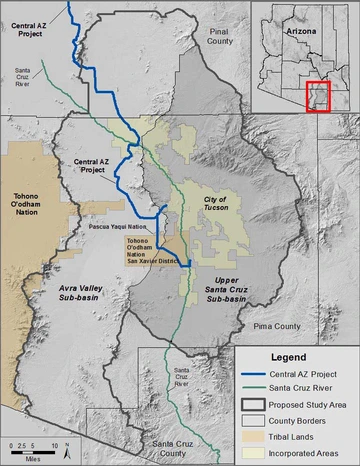by Bailey Kennett, Research Analyst, WRRC

When I first saw the email about an internship opportunity with U.S. Bureau of Reclamation’s Lower Santa Cruz River Basin Study, I didn’t give it much attention. The announcement called for a student to work on a multi-year Reclamation planning study, and stated that primary tasks involved note-taking at stakeholder meetings – neither of which were all that appealing to me. I was looking for something more exciting, some project where I could channel all the passion for water I had built over the years and was continuing to build through my graduate classes. I was looking for a platform to get the community fired up about the urgency of climate change and the critical importance of sustaining ever-threatened water supplies. Little did I know at the time that the Basin Study was just that opportunity.
On the surface, regional water planning is not very thrilling. It is often long and slow and bureaucracy-ridden. And as hard as it may be for us water wonks to understand, most people don’t find talk of groundwater flow models and rates of evapotranspiration all that exciting – go figure?! So, how then, is the Lower Santa Cruz River Basin Study such an innovative and motivating project, one that all of Tucson should get behind? Let me explain.
Climate change is happening, and it’s happening in Tucson. In the Southwest United States, the average annual temperature has increased about 1.6°F since 1901, with 2001 to 2010 being the warmest and fourth driest decade since that time. Arizona has been experiencing sustained drought for well over a decade, while the 2001-2010 average Colorado River streamflow (a major source of Tucson’s drinking water supply) was 16 percent lower than last century’s average. Looking forward, temperatures throughout the state are projected to increase 3.5 to 8.5°F by 2100, while Colorado River flow projections show decreases in the range of 9 to 29 percent by 2060. Considering these very real threats to regional water supplies, the Basin Study is taking a risk-based approach and facing the implications of these projections head on. By exploring worst case scenarios, the study encourages preparedness for climatic extremes, not just projected averages.
The Lower Santa Cruz River Basin Study is a three-year planning effort that relies on cutting edge science and local and federal expertise to understand how climate change and various socio- economic factors will impact regional water supply and demand, today through 2060. If demands are projected to outpace supply in any areas, or for any specific users within the Tucson groundwater basin, the study team will recommend strategies to mitigate these imbalances, as well as adaptation strategies to improve overall regional water reliability. Representatives from agriculture, mining, tribal communities, and environmental organizations are working alongside water providers and scientists to ensure that all of our local water needs are accounted for as we plan for the future. This collaboration of diverse, and sometimes divergent, stakeholders speaks to Tucson’s strong commitment to water stewardship and should be considered a real win in and of itself.
As a participant in all project meetings, I can confidently say that the Basin Study team is not just checking boxes on a federal checklist; they’re digging in deep and thinking outside of the box to make sure that this effort results in usable information that has the potential to make a real difference in the region. First, the study is utilizing an innovative, relatively new global climate model downscaling technique in an attempt to accurately reflect local characteristics and climate patterns. The study team will then use a variety of socio-economic and hydrologic models to develop scenarios of plausible future conditions and get an idea of where to expect water imbalances through the year 2060. A unique characteristic of this Basin Study – something the study team strongly advocated for in the initial project phases – is that it will explicitly consider environmental water needs. The study will explore how riparian ecosystems will be affected by changing climate and water supply conditions, then will develop potential adaptations to address these impacts.
The Lower Santa Cruz River Basin Study’s risk-based planning approach, use of innovative climate modeling, and consideration of environmental impacts are all precedent-setting measures that have the potential to influence future Reclamation Basin Studies. The thought of Tucson paving the way for more progressive and holistic water planning motivates me to dig into these challenges with all that I’ve got.
If you believe that innovation, collaboration, and flexibility are our best tools to tackle the very real threats of climate change – get on board with the Basin Study! Whether you’re interested in staying up-to-date on study processes and products or participating more regularly and actively as a Stakeholder Advisor, there are definite opportunities to stay informed and get involved. Your voice is what makes the Basin Study reflective of the needs and desires of the community, and your feedback has real potential to influence decision makers within and beyond Arizona. In this way, the Lower Santa Cruz River Basin Study presents a unique platform for sustained environmental engagement and provides a very practical means to address the seemingly overwhelming challenges of climate change.

